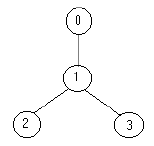Strategic game
| Time Limit: 2000MS | Memory Limit: 10000K | |
| Total Submissions: 3555 | Accepted: 1556 |
Description
Bob enjoys playing computer games, especially strategic games, but sometimes he cannot find the solution fast enough and then he is very sad. Now he has the following problem. He must defend a medieval city, the roads of which form a tree. He has to put the minimum number of soldiers on the nodes so that they can observe all the edges. Can you help him?
Your program should find the minimum number of soldiers that Bob has to put for a given tree.
For example for the tree:

the solution is one soldier ( at the node 1).
Your program should find the minimum number of soldiers that Bob has to put for a given tree.
For example for the tree:

the solution is one soldier ( at the node 1).
Input
The input contains several data sets in text format. Each data set represents a tree with the following description:
The node identifiers are integer numbers between 0 and n-1, for n nodes (0 < n <= 1500);the number_of_roads in each line of input will no more than 10. Every edge appears only once in the input data.
- the number of nodes
- the description of each node in the following format
node_identifier:(number_of_roads) node_identifier1 node_identifier2 ... node_identifiernumber_of_roads
or
node_identifier:(0)
The node identifiers are integer numbers between 0 and n-1, for n nodes (0 < n <= 1500);the number_of_roads in each line of input will no more than 10. Every edge appears only once in the input data.
Output
The output should be printed on the standard output. For each given input data set, print one integer number in a single line that gives the result (the minimum number of soldiers). An example is given in the following:
Sample Input
4
0:(1) 1
1:(2) 2 3
2:(0)
3:(0)
5
3:(3) 1 4 2
1:(1) 0
2:(0)
0:(0)
4:(0)
Sample Output
1
2
Source
Southeastern Europe 2000
/*
ans[i][0]表示在不选择节点i的情况下,以i为根节点的子树,最少需要选择的点数;
ans[i][1]表示在选择节点i的情况下,以i为根节点的子树,最少需要选择的点数;
当i是叶子时,ans[i][0]=0,ans[i][1]=1;
else
ans[i][0]=sigma(ans[j][1])(j为i的子节点)
ans[i][1]=1+sigmamin(ans[j][0],ans[j][1]);
*/
#include<iostream>
#include<cstdio>
using namespace std;
int min(int a,int b)
{
if(a>b) return b;
else return a;
}
int dp[1505][2];
int child[1505];
int pos[1505];
struct EDGE
{
int from,to;
}edge[1505];
void FindDp(int st)//递归时是把st压入栈中的,不是to
{
int to;
dp[st][0] = 0;
dp[st][1] = 1;
if(child[st] == 0) return ;//当递归到叶子节点就返回
int i = pos[st];
while(edge[i].from == st)
{
to = edge[i++].to;
FindDp(to);//从儿子节点继续递归搜
dp[st][0] += dp[to][1];
dp[st][1] += min(dp[to][0],dp[to][1]);
}
}
int main()
{
int n;
int parent,sum;
int num;
int t,count,level;
while(scanf("%d",&n) != EOF)
{
num = level = 0;
count = 1;
for(int j =1;j<=n;j++)
{
scanf("%d:(%d)",&parent,&sum);
num += parent;
pos[parent] = count;
child[parent] = sum;
for(int i =1;i <= sum;i++)
{
scanf("%d",&t);
level += t;
edge[count].from = parent;
edge[count++].to = t;
}
}
int find = num - level;//记录根节点
FindDp(find);//从根节点开始递归
printf("%d\n",min(dp[find][0],dp[find][1]));
}
}
/*
ans[i][0]表示在不选择节点i的情况下,以i为根节点的子树,最少需要选择的点数;
ans[i][1]表示在选择节点i的情况下,以i为根节点的子树,最少需要选择的点数;
当i是叶子时,ans[i][0]=0,ans[i][1]=1;
else
ans[i][0]=sigma(ans[j][1])(j为i的子节点)
ans[i][1]=1+sigmamin(ans[j][0],ans[j][1]);
*/
#include<iostream>
#include<cstdio>
using namespace std;
int min(int a,int b)
{
if(a>b) return b;
else return a;
}
int dp[1505][2];
int child[1505];
int pos[1505];
struct EDGE
{
int from,to;
}edge[1505];
void FindDp(int st)//递归时是把st压入栈中的,不是to
{
int to;
dp[st][0] = 0;
dp[st][1] = 1;
if(child[st] == 0) return ;//当递归到叶子节点就返回
int i = pos[st];
while(edge[i].from == st)
{
to = edge[i++].to;
FindDp(to);//从儿子节点继续递归搜
dp[st][0] += dp[to][1];
dp[st][1] += min(dp[to][0],dp[to][1]);
}
}
int main()
{
int n;
int parent,sum;
int num;
int t,count,level;
while(scanf("%d",&n) != EOF)
{
num = level = 0;
count = 1;
for(int j =1;j<=n;j++)
{
scanf("%d:(%d)",&parent,&sum);
num += parent;
pos[parent] = count;
child[parent] = sum;
for(int i =1;i <= sum;i++)
{
scanf("%d",&t);
level += t;
edge[count].from = parent;
edge[count++].to = t;
}
}
int find = num - level;//记录根节点
FindDp(find);//从根节点开始递归
printf("%d\n",min(dp[find][0],dp[find][1]));
}
}





 本文介绍了一种解决特定战略游戏问题的方法,该游戏的目标是在一棵树形结构的城市中部署最少数量的士兵来监视所有道路。文章详细阐述了使用动态规划算法进行求解的过程,并提供了完整的代码实现。
本文介绍了一种解决特定战略游戏问题的方法,该游戏的目标是在一棵树形结构的城市中部署最少数量的士兵来监视所有道路。文章详细阐述了使用动态规划算法进行求解的过程,并提供了完整的代码实现。
















 229
229

 被折叠的 条评论
为什么被折叠?
被折叠的 条评论
为什么被折叠?








